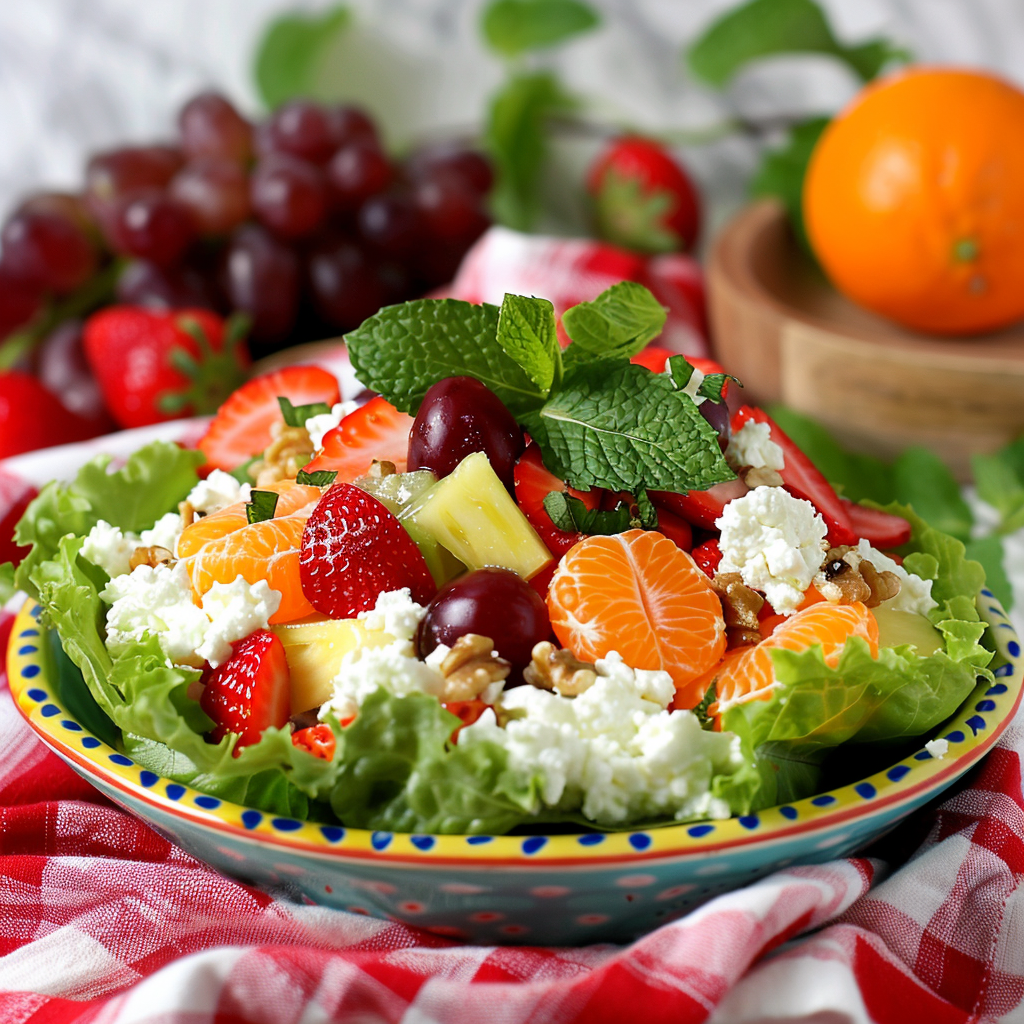Classic Fruit Salad with Cottage Cheese – A Nostalgic and Nutritious Dish

Share
Fruit and Cottage Cheese Salads Are a Reminder of a Popular Menu Item When I Was Growing Up
My Aunty owned a cute little café, and when I was growing up, we were often recruited to wash dishes and peel potatoes. I vividly recall watching her make this really pretty, colorful dish that was always a hit with customers. She would place a bright leaf of iceberg lettuce on a plate, top it with a generous dollop of cottage cheese, and then artfully arrange colorful pieces of fruit on top. It was always served with a side of toast, and customers couldn’t get enough of it. This simple yet delightful dish was a popular food back then, and yes, I’m definitely giving away that this was decades ago! Despite the passing years, the charm and appeal of this salad remain the same, making it a classic in my eyes.
Did You Know?
The tradition of serving fruit salad with cottage cheese on a lettuce leaf dates back to the mid-20th century. This simple yet elegant dish was popular at luncheons and tea parties. Cottage cheese is rich in protein and calcium, making it a healthy complement to the vitamins and antioxidants found in the fresh fruits. Pineapple is known for its enzyme bromelain, which aids digestion, while strawberries and grapes provide a good dose of vitamins C and K, essential for skin health and blood clotting. Mandarin oranges are an excellent source of fiber and vitamin A, promoting good vision and immune health. This classic dish is not only nostalgic but also nutritious and refreshing, perfect for a light summer meal.
Yield: 4 servings
Ingredients:
- 1 cup cottage cheese
- 4 large lettuce leaves
- 1 cup pineapple chunks
- 1 cup strawberries, sliced
- 1 cup grapes, halved
- 1 cup mandarin orange segments
- 1/4 cup chopped walnuts (optional)
- Fresh mint leaves for garnish
Instructions:
Prepare the Base:
Place one lettuce leaf on each plate.
Personal Tip: Using crisp, fresh lettuce will provide a nice contrast to the creamy cottage cheese.
Add Cottage Cheese:
Scoop 1/4 cup of cottage cheese onto each lettuce leaf.
Personal Tip: If you prefer a smoother texture, you can whip the cottage cheese slightly before serving.
Add Fruits:
Arrange the pineapple chunks, sliced strawberries, halved grapes, and mandarin orange segments around the cottage cheese.
Personal Tip: For extra flavor, try using a mix of seasonal fruits to complement the cottage cheese.
Optional Toppings:
Sprinkle with chopped walnuts if desired.
Personal Tip: Toasting the walnuts lightly before adding them can enhance their flavor and crunch.
Garnish and Serve:
Garnish with fresh mint leaves and serve immediately.
Personal Tip: A drizzle of honey can add a touch of sweetness that pairs well with the tangy cottage cheese.
Nutritional Information (Per Serving):
Calories: 150, Protein: 10g, Carbohydrates: 22g, Sugars: 16g, Total Fat: 3g, Saturated Fat: 1g, Sodium: 400mg, Fiber: 4g
Kitchen Tips, Great Ideas, How to Save Money
-
Selecting Fresh Fruits: Always choose fresh, ripe fruits for the best flavor and nutritional value. Seasonal fruits are usually cheaper and taste better.
Keywords: fresh fruits, seasonal fruits, ripe fruits. -
Storing Fruits: Store fruits like strawberries and grapes in the refrigerator to keep them fresh longer. Pineapple and oranges can be kept at room temperature until ripe.
Keywords: store fruits, keep fresh longer, refrigerator storage. -
Prepping Ahead: You can prepare the fruits and store them in separate containers in the refrigerator to save time. Combine them just before serving to maintain freshness.
Keywords: meal prep, prepare ahead, save time. -
Cottage Cheese Alternatives: If you prefer, you can substitute cottage cheese with Greek yogurt for a similar protein boost and creamy texture.
Keywords: cottage cheese alternatives, Greek yogurt, protein boost. -
Adding Crunch: Walnuts are a great addition for extra crunch and healthy fats. You can also use almonds or pecans as alternatives.
Keywords: healthy fats, add crunch, walnuts, almonds, pecans. -
Enhancing Flavors: Add a drizzle of honey or a squeeze of lemon juice over the salad for an extra touch of sweetness and tanginess.
Keywords: enhance flavors, add sweetness, honey, lemon juice. -
Budget-Friendly Tips: Buy fruits in bulk when they are in season and freeze any extras for later use. This helps save money and reduces waste.
Keywords: budget-friendly, buy in bulk, save money, reduce waste. -
Creative Presentation: For a visually appealing presentation, arrange the fruits in a colorful pattern around the cottage cheese. Use a large, colorful platter for serving.
Keywords: creative presentation, visually appealing, colorful pattern. -
Leftover Ideas: If you have any leftover fruits, use them in smoothies, yogurt bowls, or as toppings for oatmeal.
Keywords: use leftovers, smoothie recipes, yogurt bowls, oatmeal toppings. -
Nutritional Boost: Incorporate chia seeds or flaxseeds into the salad for an added boost of omega-3 fatty acids and fiber.
Keywords: nutritional boost, chia seeds, flaxseeds, omega-3 fatty acids, fiber.
What’s the Difference in the Percentages in Cottage Cheese? What Does That All Mean?
When you buy cottage cheese, you’ll notice that it comes in various fat content percentages, such as 1%, 2%, 4%, and even non-fat versions. These percentages indicate the amount of milk fat present in the cottage cheese. A higher percentage means richer, creamier cottage cheese with more fat content, while lower percentages offer a leaner option with less fat. Choosing the right type depends on your dietary preferences and health goals. Full-fat cottage cheese is creamier and more satisfying, making it a good choice for those who enjoy a richer texture. Lower-fat versions are lighter and often used by those looking to reduce their fat intake while still getting the benefits of protein and calcium.


